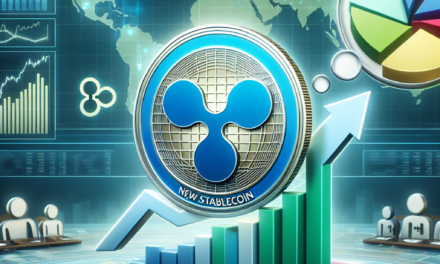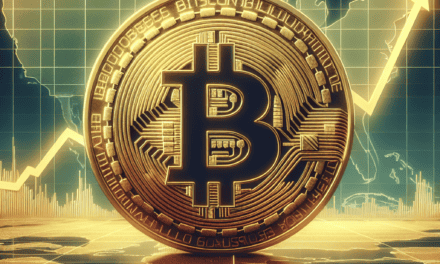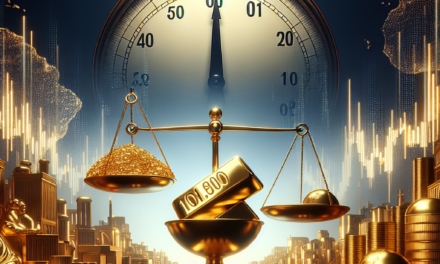“Riding the Wave: Futures Soar in Post-Election Surge”
Introduction
Following a period of heightened political uncertainty, futures markets are experiencing a notable upswing as part of an ongoing post-election rally. Investors are responding positively to the resolution of electoral outcomes, which has alleviated some of the market’s recent volatility. This upward momentum is being driven by renewed investor confidence, expectations of favorable policy shifts, and a general sense of economic optimism. As market participants adjust their portfolios in anticipation of potential legislative and regulatory changes, the rally reflects a broader sentiment of stability and growth prospects in the post-election landscape.
Market Trends: Analyzing the Post-Election Rally Impact on Futures
In the wake of the recent election, financial markets have experienced a notable surge, with futures climbing higher as investors respond to the evolving political landscape. This post-election rally has been characterized by a renewed sense of optimism, as market participants anticipate potential policy shifts and economic reforms that could stimulate growth. The rally has been fueled by a combination of factors, including investor sentiment, economic indicators, and geopolitical developments, all of which have contributed to the upward trajectory of futures.
To begin with, investor sentiment has played a crucial role in driving the post-election rally. The election results have provided a degree of clarity and stability, which has been welcomed by investors who were previously uncertain about the political direction. This newfound confidence has translated into increased market activity, with investors eager to capitalize on potential opportunities. Moreover, the anticipation of policy changes, such as tax reforms and infrastructure spending, has further bolstered investor enthusiasm, as these measures are expected to have a positive impact on economic growth.
In addition to investor sentiment, economic indicators have also supported the upward movement of futures. Recent data releases have shown signs of economic resilience, with improvements in key areas such as employment, consumer spending, and manufacturing output. These positive indicators have reinforced the belief that the economy is on a stable footing, providing further impetus for the rally. Furthermore, central banks have maintained accommodative monetary policies, which have helped to sustain market momentum by ensuring ample liquidity and low borrowing costs.
Geopolitical developments have also influenced the post-election rally, as investors assess the potential implications of the new political landscape on international relations and trade. The election outcome has raised hopes for a more collaborative approach to global issues, which could lead to improved trade relations and reduced geopolitical tensions. This prospect has been particularly appealing to investors, who are keen to see a more stable and predictable global environment that supports economic growth.
As the rally continues, it is important to consider the potential risks and challenges that could impact the trajectory of futures. While the current optimism is well-founded, there are still uncertainties that could pose challenges to sustained market growth. For instance, the implementation of proposed policy changes may face obstacles, such as political gridlock or regulatory hurdles, which could delay or dilute their impact. Additionally, external factors, such as global economic conditions and geopolitical tensions, could also influence market dynamics and investor sentiment.
In conclusion, the post-election rally has been a significant development in financial markets, with futures climbing higher amid a backdrop of optimism and anticipation. Investor sentiment, economic indicators, and geopolitical developments have all contributed to this upward trend, reflecting a complex interplay of factors that have shaped market dynamics. While the rally presents opportunities for investors, it is essential to remain vigilant and consider potential risks that could affect future market performance. As the political and economic landscape continues to evolve, market participants will need to stay informed and adaptable to navigate the challenges and opportunities that lie ahead.
Investor Sentiment: How Confidence Drives Futures Higher
In the wake of a significant electoral event, investor sentiment often plays a pivotal role in shaping market dynamics, particularly in the futures market. The recent post-election rally has been no exception, as futures have climbed higher, buoyed by a wave of optimism and confidence among investors. This phenomenon underscores the intricate relationship between investor sentiment and market performance, highlighting how confidence can act as a catalyst for upward momentum in futures trading.
To begin with, it is essential to understand the nature of futures contracts and their role in the financial markets. Futures are standardized agreements to buy or sell an asset at a predetermined price at a specified time in the future. They are widely used by investors to hedge against risks or speculate on price movements. The futures market is highly sensitive to changes in investor sentiment, as it reflects expectations about future economic conditions and market trends. Consequently, when investor confidence is high, it often translates into increased demand for futures contracts, driving prices upward.
The recent post-election rally has been characterized by a surge in investor confidence, fueled by several factors. Firstly, the resolution of electoral uncertainty has provided a sense of stability and predictability, which is crucial for market participants. Elections often bring about a period of uncertainty, as investors grapple with potential policy changes and their implications for the economy. Once the election results are clear, and the political landscape becomes more defined, investors can make more informed decisions, leading to increased market activity and higher futures prices.
Moreover, the post-election period has seen a renewed focus on economic recovery and growth prospects. Investors are optimistic about the potential for new policies and initiatives that could stimulate economic activity and drive corporate earnings. This optimism is reflected in the futures market, where traders anticipate improved economic conditions and are willing to pay a premium for contracts that align with their positive outlook. As a result, futures prices have experienced an upward trajectory, mirroring the broader sentiment of confidence and hope for a brighter economic future.
In addition to these factors, the role of institutional investors cannot be overlooked. Large institutional players, such as hedge funds and asset managers, have significant influence over market trends due to their substantial trading volumes. Their actions often serve as a barometer for broader market sentiment. In the current post-election environment, many institutional investors have adopted a bullish stance, further reinforcing the upward momentum in futures markets. Their confidence in the market’s direction encourages other investors to follow suit, creating a self-reinforcing cycle of optimism and rising prices.
Furthermore, it is important to consider the impact of global economic conditions on investor sentiment and futures markets. In an interconnected world, developments in major economies can have far-reaching effects on market dynamics. Positive economic indicators from key regions, such as robust GDP growth or declining unemployment rates, can bolster investor confidence and contribute to the rally in futures prices. Conversely, negative developments can dampen sentiment and lead to market volatility. Therefore, the interplay between domestic and international factors is crucial in shaping investor sentiment and driving futures higher.
In conclusion, the ongoing post-election rally in futures markets is a testament to the power of investor sentiment in influencing market trends. As confidence continues to build, driven by political stability, economic optimism, and institutional participation, futures are likely to maintain their upward trajectory. Understanding the factors that contribute to this sentiment-driven momentum is essential for investors seeking to navigate the complexities of the futures market and capitalize on emerging opportunities.
Economic Indicators: Key Factors Influencing the Futures Market
In the wake of a significant post-election rally, futures markets have experienced a notable climb, reflecting a complex interplay of economic indicators that continue to shape investor sentiment. This upward trajectory in futures is not merely a reaction to political outcomes but is deeply intertwined with a variety of economic factors that influence market dynamics. Understanding these key factors provides insight into the current and future state of the futures market.
Firstly, investor confidence plays a pivotal role in the movement of futures. The recent election results have instilled a sense of stability and predictability, which are crucial for market participants. When political uncertainty diminishes, investors are more likely to engage in risk-taking behaviors, driving futures higher. This confidence is further bolstered by the anticipation of favorable economic policies that are expected to stimulate growth and enhance corporate profitability. As a result, the futures market often acts as a barometer for investor sentiment, reflecting broader economic expectations.
Moreover, economic indicators such as GDP growth, employment rates, and consumer spending are fundamental in shaping futures market trends. A robust GDP growth rate signals a healthy economy, encouraging investors to bet on future economic expansion. Similarly, strong employment figures suggest increased consumer spending power, which can lead to higher corporate earnings and, consequently, a rise in futures. Conversely, any signs of economic slowdown or negative indicators can temper the enthusiasm in the futures market, highlighting the delicate balance between optimism and caution.
In addition to domestic economic indicators, global economic conditions also exert significant influence on the futures market. In an increasingly interconnected world, events in major economies such as China, the European Union, and emerging markets can have ripple effects across global markets. For instance, trade policies, geopolitical tensions, and international economic agreements can either bolster or undermine investor confidence, thereby impacting futures. As such, market participants must remain vigilant, monitoring global developments that could affect their positions.
Furthermore, central bank policies are another critical factor influencing futures. Interest rate decisions, quantitative easing measures, and other monetary policies implemented by central banks can have profound effects on market liquidity and investor behavior. Lower interest rates typically encourage borrowing and investment, leading to increased market activity and higher futures. Conversely, tightening monetary policies can dampen market enthusiasm, as higher borrowing costs may deter investment. Therefore, central bank communications and policy shifts are closely watched by investors seeking to anticipate market movements.
Additionally, technological advancements and innovations in trading platforms have transformed the futures market landscape. The rise of algorithmic trading and high-frequency trading has increased market efficiency, allowing for quicker execution of trades and more accurate pricing. These technological developments have also democratized access to the futures market, enabling a broader range of participants to engage in trading activities. Consequently, the increased participation and liquidity contribute to the overall dynamism of the futures market.
In conclusion, the ongoing post-election rally in futures is a multifaceted phenomenon driven by a confluence of economic indicators. Investor confidence, domestic and global economic conditions, central bank policies, and technological advancements all play integral roles in shaping the futures market. As these factors continue to evolve, they will undoubtedly influence the trajectory of futures, underscoring the importance of staying informed and adaptable in an ever-changing economic landscape.
Sector Performance: Winners and Losers in the Post-Election Rally
In the wake of the recent election, financial markets have experienced a notable surge, with futures climbing higher as investors respond to the evolving political landscape. This post-election rally has been characterized by a distinct shift in sector performance, highlighting both winners and losers as market participants recalibrate their strategies. As the dust settles, it becomes increasingly clear which sectors are poised to benefit from the new administration’s policies and which may face headwinds.
To begin with, the technology sector has emerged as a significant winner in this post-election rally. Investors have shown renewed confidence in tech companies, driven by expectations of continued innovation and growth. The sector’s resilience during the pandemic has only bolstered its appeal, as remote work and digital transformation trends persist. Moreover, the potential for favorable regulatory conditions under the new administration has further fueled optimism, leading to a surge in tech stocks. As a result, technology companies have seen their valuations climb, contributing to the overall upward momentum in the markets.
In contrast, the energy sector has faced challenges amid the post-election rally. With the new administration prioritizing clean energy initiatives and environmental sustainability, traditional energy companies, particularly those reliant on fossil fuels, have encountered increased scrutiny. This shift in policy focus has led to a reallocation of capital towards renewable energy sources, causing a divergence in performance within the sector. While some energy companies have adapted by investing in green technologies, others have struggled to keep pace, resulting in a mixed performance for the sector as a whole.
Meanwhile, the healthcare sector has experienced a nuanced response to the post-election environment. On one hand, the potential for expanded healthcare coverage and increased government spending on public health initiatives has provided a boost to certain segments, such as pharmaceuticals and biotechnology. These industries stand to benefit from increased demand for innovative treatments and vaccines. On the other hand, concerns about potential regulatory changes and pricing pressures have tempered enthusiasm for some healthcare providers, leading to a more cautious approach among investors.
The financial sector has also been a focal point during this rally, with banks and financial institutions experiencing a resurgence in investor interest. The prospect of economic recovery and rising interest rates has improved the outlook for banks, which stand to benefit from increased lending activity and higher net interest margins. Additionally, the potential for regulatory reforms that could ease some of the constraints imposed on the sector in recent years has further bolstered confidence. However, it is important to note that the sector’s performance remains closely tied to broader economic conditions, and any setbacks in the recovery could impact its trajectory.
In summary, the post-election rally has underscored the dynamic nature of sector performance, with technology and financials emerging as clear winners, while energy and healthcare present a more complex picture. As investors navigate this evolving landscape, they must remain vigilant, considering both the opportunities and challenges that lie ahead. The interplay between policy changes and market dynamics will continue to shape sector performance, making it essential for market participants to stay informed and adaptable. Ultimately, the ability to anticipate and respond to these shifts will be crucial in identifying the winners and losers in this ongoing rally.
Global Markets: The International Influence on U.S. Futures
In the wake of the recent election, U.S. futures have experienced a notable upswing, reflecting a broader trend of optimism in global markets. This post-election rally is not occurring in isolation; rather, it is intricately linked to international economic dynamics and investor sentiment worldwide. As investors digest the implications of the election results, they are also considering the broader global economic landscape, which plays a crucial role in shaping U.S. futures.
To begin with, the election outcome has provided a degree of political clarity, which is often a catalyst for market stability. Investors tend to favor predictability, and the resolution of electoral uncertainty has allowed them to refocus on economic fundamentals. However, the influence of global markets on U.S. futures cannot be overstated. For instance, the performance of major international indices, such as the FTSE 100 and the Nikkei 225, often sets the tone for U.S. market openings. A positive performance in these markets can lead to a ripple effect, boosting investor confidence and encouraging a bullish outlook in U.S. futures.
Moreover, central bank policies across the globe significantly impact U.S. futures. The monetary policies of major economies, such as the European Central Bank and the Bank of Japan, influence global liquidity and interest rates, which in turn affect U.S. market conditions. For example, if these central banks adopt an accommodative stance, it can lead to increased capital flows into U.S. markets, driving futures higher. Conversely, tightening measures can have the opposite effect, underscoring the interconnectedness of global financial systems.
In addition to central bank policies, geopolitical developments also play a pivotal role in shaping market sentiment. Trade relations, particularly between the U.S. and major economies like China and the European Union, are closely monitored by investors. Any positive developments in trade negotiations can lead to a surge in market optimism, as they are perceived to enhance economic growth prospects. This optimism is often reflected in the upward movement of U.S. futures, as investors anticipate improved corporate earnings and economic expansion.
Furthermore, the global economic recovery from the pandemic continues to be a significant factor influencing U.S. futures. As countries gradually emerge from the economic downturn caused by COVID-19, the pace and sustainability of this recovery are critical considerations for investors. Strong economic data from key regions, such as robust GDP growth or declining unemployment rates, can bolster confidence in a sustained recovery, thereby supporting higher futures.
Additionally, commodity prices, particularly oil and metals, are closely watched by market participants. Fluctuations in these prices can have a direct impact on U.S. futures, as they affect the profitability of various sectors, including energy and manufacturing. A rise in commodity prices often signals increased demand and economic activity, which can be a positive indicator for futures markets.
In conclusion, while the post-election rally in U.S. futures is partly driven by domestic factors, the influence of global markets is undeniable. International economic conditions, central bank policies, geopolitical developments, and the ongoing recovery from the pandemic all play a crucial role in shaping investor sentiment and market dynamics. As such, understanding these global influences is essential for comprehending the trajectory of U.S. futures in the current economic environment.
Trading Strategies: Navigating the Post-Election Futures Landscape
In the wake of the recent election, futures markets have experienced a notable upswing, reflecting a wave of optimism among investors. This post-election rally has been characterized by a surge in futures prices, driven by a combination of political stability and anticipated economic policies. As traders navigate this evolving landscape, it is crucial to adopt informed strategies that capitalize on the prevailing market sentiment while mitigating potential risks.
The post-election period often brings a sense of clarity and direction, as market participants adjust their expectations based on the newly elected administration’s policy agenda. In this context, futures markets serve as a barometer of investor sentiment, with rising futures prices indicating confidence in the economic outlook. This optimism is often fueled by expectations of fiscal stimulus, regulatory changes, and other policy measures that could spur economic growth. Consequently, traders are keen to position themselves advantageously to benefit from these anticipated developments.
To effectively navigate the post-election futures landscape, traders should first conduct a comprehensive analysis of the political and economic environment. Understanding the implications of the election results on key sectors and industries is essential for identifying potential opportunities. For instance, if the new administration prioritizes infrastructure spending, traders might consider increasing their exposure to futures contracts related to construction materials or industrial equipment. Similarly, if regulatory changes are expected in the energy sector, adjusting positions in oil or natural gas futures could prove beneficial.
Moreover, it is important for traders to remain vigilant and adaptable, as the post-election period can also bring volatility and uncertainty. While the initial rally may suggest a positive outlook, unforeseen developments or policy shifts could quickly alter market dynamics. Therefore, employing risk management strategies is crucial to protect against adverse price movements. Techniques such as setting stop-loss orders, diversifying portfolios, and maintaining a balanced approach can help mitigate potential losses and preserve capital.
In addition to analyzing the macroeconomic environment, traders should also pay attention to technical indicators and market trends. By examining historical price patterns and chart formations, traders can gain insights into potential future movements. Technical analysis tools, such as moving averages, relative strength index (RSI), and Fibonacci retracements, can provide valuable signals for entry and exit points. Combining these technical insights with a solid understanding of the fundamental factors at play can enhance decision-making and improve trading outcomes.
Furthermore, staying informed about global events and geopolitical developments is essential in the interconnected world of futures trading. International trade agreements, diplomatic relations, and geopolitical tensions can all have significant impacts on futures markets. By keeping abreast of these developments, traders can anticipate potential disruptions or opportunities that may arise, allowing them to adjust their strategies accordingly.
In conclusion, the post-election rally in futures markets presents both opportunities and challenges for traders. By conducting thorough analyses of the political and economic landscape, employing effective risk management strategies, and leveraging technical and fundamental insights, traders can navigate this dynamic environment with confidence. As futures climb higher amid ongoing optimism, a well-informed and adaptable approach will be key to capitalizing on the evolving market conditions and achieving successful trading outcomes.
Historical Context: Comparing Past Post-Election Market Rallies
In the wake of the recent election, financial markets have experienced a notable upswing, with futures climbing higher as part of an ongoing post-election rally. This phenomenon is not unprecedented; historical analysis reveals that markets often react positively following elections, driven by a combination of investor optimism and policy expectations. To better understand the current market dynamics, it is instructive to compare this rally with past post-election market behaviors, thereby providing a broader context for the ongoing financial trends.
Historically, post-election rallies have been influenced by several factors, including the political landscape, economic conditions, and investor sentiment. For instance, the post-election rally following the 1980 U.S. presidential election saw significant market gains, largely attributed to the pro-business policies anticipated under the new administration. Similarly, the 1992 election resulted in a market upswing as investors responded to the promise of economic reform and fiscal responsibility. These examples underscore the importance of policy expectations in shaping market movements.
Moreover, the 2008 election provides another illustrative case. In the aftermath of a global financial crisis, markets initially reacted with caution. However, as the new administration’s economic recovery plans became clearer, investor confidence gradually returned, leading to a sustained rally. This highlights the role of economic conditions in moderating the impact of political transitions on market performance. In contrast, the 2016 election saw an immediate and robust market rally, driven by expectations of deregulation and tax reforms. This rapid response was indicative of the market’s sensitivity to anticipated policy shifts, particularly those perceived as favorable to business growth.
Transitioning to the present, the current post-election rally can be seen as part of this historical continuum. Investors are once again navigating a complex interplay of political and economic factors. The recent election has introduced new policy directions, which are being closely scrutinized by market participants. As in previous rallies, the anticipation of policy changes—ranging from fiscal stimulus to regulatory adjustments—has fueled investor optimism, contributing to the upward trajectory of futures.
Furthermore, the global economic context cannot be overlooked. The ongoing recovery from the pandemic-induced downturn has created a backdrop of cautious optimism. As economies reopen and vaccination efforts continue, there is a growing expectation of economic normalization, which has further buoyed market sentiment. This optimism is reflected in the current rally, as investors position themselves to capitalize on potential growth opportunities.
In addition, technological advancements and shifts in consumer behavior, accelerated by the pandemic, are also playing a role in shaping market expectations. Sectors such as technology and healthcare have seen increased investor interest, driven by the belief that these industries will continue to thrive in a post-pandemic world. This sectoral focus is reminiscent of past rallies, where certain industries have outperformed based on prevailing economic and technological trends.
In conclusion, the ongoing post-election rally, characterized by climbing futures, is part of a historical pattern of market behavior following elections. By examining past rallies, we gain valuable insights into the factors that drive market movements in the wake of political transitions. As investors navigate the current landscape, they are guided by a combination of policy expectations, economic conditions, and sectoral trends, all of which contribute to the evolving narrative of post-election market dynamics.
Q&A
1. **What are futures?**
Futures are financial contracts obligating the buyer to purchase, or the seller to sell, an asset at a predetermined future date and price.
2. **What is a post-election rally?**
A post-election rally refers to the increase in stock market prices following an election, often due to investor optimism about the new government’s policies.
3. **Why might futures climb higher after an election?**
Futures might climb higher due to increased investor confidence in the economic policies of the newly elected government, leading to expectations of economic growth.
4. **What factors contribute to a post-election rally?**
Factors include anticipated policy changes, reduced political uncertainty, and positive investor sentiment regarding the new administration’s economic agenda.
5. **How do futures impact the stock market?**
Futures can impact the stock market by influencing investor expectations and sentiment, which can lead to increased buying or selling activity in the market.
6. **What role do economic indicators play in futures trading post-election?**
Economic indicators provide insights into the health of the economy, influencing futures prices as traders adjust their positions based on expected economic performance.
7. **Can a post-election rally be sustained long-term?**
A post-election rally can be sustained if the new government’s policies lead to actual economic improvements, but it may falter if expectations are not met or if other negative factors arise.
Conclusion
The ongoing post-election rally has led to a significant climb in futures, reflecting increased investor optimism and confidence in the market’s direction. This upward trend suggests that market participants are anticipating favorable economic policies and stability following the election results. The rally may also be driven by expectations of continued fiscal stimulus and accommodative monetary policies, which are likely to support economic growth and corporate earnings. However, while the current momentum is positive, investors should remain cautious of potential volatility and external factors that could impact market dynamics in the future.





